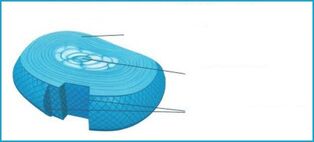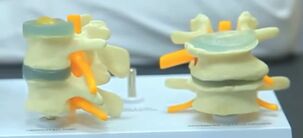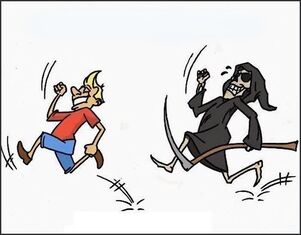Important functions of the spine
We must not forget that our back has 3 main functions.
- Pivot - keeps the body on its feet.
- Protective - protects the spinal cord.
- Amortization - ligaments, jumps soften the most varied movements of our body.

The spine absorbs every load in all areas, thanks to the unique intervertebral discs located in the structure of the spine.
The concept of the word "osteochondrosis"
The term "osteochondrosis" is used only in Russia, in the West they abandoned this name and instead use the concept of "degenerative disease of the intervertebral disc or cartilage, it may also be called so". This definition reflects the essence of what happens on disks.
Result: if osteochondrosis - degeneration (dystrophy) of the intervertebral cartilage by primitive movements. The conclusion from this definition is as follows: dystrophy - a violation of tissue nutrition, and degeneration is a change in tissue for the worse.
Even understanding the meaning of these words, it is clear what is going on in the back and where does such a famous disease "osteochondrosis" come from. By the way, what kind of disease is this? Simple - premature aging.
Degeneration has four stages and stages of development, takes place in all three departments. Osteochondrosis occurs:
- cervix;
- chest;
- mesit.
Tissue malnutrition
Tissues are nourished by the large circulatory system. Arteries, veins, vessels and capillaries, as well as muscle tissue, are all actively involved in the nutrition process. Along with the blood, important nutrients are transported to the vertebrae, cartilage and muscles, contracting, helping the blood to move at the right speed.
Discs, which have no blood vessels, absorb water and nutrients at the moment of relaxation of the vertebrae. And when you press them, the same segments, on the contrary, give redundancy. So, it turns out that during the amortization of the spine, due to compression and expansion, the discs are saturated and cleaned by the method of osmosis. The more often osmosis occurs, the more satisfying and nourishing they are.
It is the muscles that surround the vertebrae from behind that carry out the movement process. It is not difficult to imagine if the muscles around the spine are not very mobile, blood circulation is slow and full metabolism is impaired. Cartilage suffers from malnutrition and can not be elastic and strong because spinal dystrophy develops too much.
In the early stages of dystrophy, the inclusion of regular athletic movement in life can still be corrected fairly quickly. The younger generation has hope for a full recovery.
What happens next? For a long time, being in a stationary state, the muscles weaken, the ligaments stretch and atrophy to such an extent that they can not keep the back in anatomical shape and even, different types of bends appear:
- lordoza;
- kyphosis;
- scoliosis.
Discs that do not receive the necessary nutrition from the circulatory system for a long time and a sufficient amount of fluid for a full existence begin to collapse. That is, degeneration occurs, a slow modification (destruction). Greatly made a diagnosis - "Osteochondrosis" with all the symptoms and long-term treatment with drugs that are not very effective without exercise therapy.
The fact is that the cartilage nucleus, which is 80% water, is the water that gives it elasticity, loses its elasticity in nature with age and a sedentary lifestyle accelerates this process. Therefore, the power of the disc slows down, less water flows and it becomes thinner in height. But water and useful elements are needed not only for the disk, but for all the components around it:
- tendinat;
- muscles;
- fascia; connections
- .
Osteochondrosis is a complex of dystrophic disorders in the cartilage and segments. Most often, intervertebral lining is affected, but it also develops in the joints, only there are different names - osteoarthritis, arthritis (how do these diseases differ, here), coxarthrosis and many other pathologies.But from old age, due to slow blood circulation, part of the capillaries still dry out, because for decades they were not needed, the process of osteochondrosis takes root. At this age, it takes effort to be in shape.
Symptoms and treatment of spinal osteochondrosis
Reasons
There are external and internal causes of osteochondrosis, which lead to injuries.
- Internal ones include genetics, tissue malnutrition at a young age, the elderly (this was mentioned above), nerve stresses that spasm muscles and stay in this state for a long time, or maybe forever, forming trigger points.
- Externally (trauma, low and excessive physical activity).
Clear reasons for internal and external factors can not be discussed, except old age. People go to the aging of the musculoskeletal system thanks to their laziness, from the moment they become independent. Understanding the benefits of morning exercise, a healthy lifestyle, at least in part, we consciously use every excuse, excuse to do nothing. I do not hide, I was like that myself.
Complications
Dystrophic changes in the intervertebral disc itself are not a big deal. Many live for a long time, they do not go to the doctors, as they are not very worried about the complications of osteochondrosis. But for a variety of reasons, severe pain often occurs. After visiting a doctor, a person gets a whole bunch of complications identified after the examination, such as elongation, hernia, spondylosis (osteophyte) and vertebral instability.
These complications are believed to lead to painful symptoms when compression occurs at the nerve endings at the level of the disc of any part of the spine. In addition to pain, there may be a manifestation of weakness, decreased sensitivity, small pelvic dysfunction, increased blood pressure, in severe cases, paralysis.
- The protrusion is a slight extension of the anal fibrosus beyond the boundaries of the vertebral body, due to an increase in the nucleus pulposus, sometimes cracks appear in the fibrous layers of the ring.
- A herniated disc is the fibrosus ring release. The cartilage has lost its elasticity and is divided into parts, and the excessive load of this condition causes it to protrude, so a hernia appears. It can irritate the nerve root that emerges at the level of the vertebra from the spinal canal, then the pain occurs with localization in one or another area of the body. Osteophytes - changes in the vertebral bodies themselves, the height of the disc decreases so much that its marginal bone growths (which are called osteophytes) begin their destructive activity in relation to our health. The size of the hole through which the spinal nerve emerges, i. e. its root, decreases.
There is also a different opinion about the appearance of discomfort and pain, forcing you to see a specialist. Soft tissue pathologies (muscles, ligaments, tendons, fascia). Everything that moves our skeleton, and they are the ones that signal, for start-up problems, sending a painful impulse. Diagnosis is made - sciatica, myositis, myalgia and much more and all this, ostensibly, symptoms on the background of osteochondrosis of the back and treatment is prescribed in the form of painkillers. And then everything repeats itself again, a vicious circle.
In women after 50-55 years, the disappearance of reproductive functions begins. It enters the climatic phase. It would seem like a natural transition, what can you do here. But if you do not take hormone replacement therapy or at least dietary supplements. Osteoporosis then develops rapidly, which is often confused with osteochondrosis.
Diagnosis of spinal osteochondrosis
Self-diagnosis
- You can determine for yourself whether it is there or not. To do this, simply estimate how often your back hurts. How quickly she gets tired of the little physical work, stress. If there is weight, discomfort, sometimes pain, then the changes are already happening inside the spine. Because a healthy person does not feel such symptoms in the back, he is simply healthy. Although now there are hardly any healthy ones.
- it is necessary to determine the flexibility of the spine. Flexibility depends entirely on the extent. The better it is, the healthier the spine.
Diagnosis in a polyclinic
At the doctor's appointment, to make an accurate diagnosis, a referral for an X-ray is given. And then the appropriate treatment is prescribed.

Comparative representations for healthy and diseased segment. The layout shows how the vertebral disc and the body of the segment are the ideal structures created by nature. Nerve endings move freely, are not compressed, the disc is high and has a large safety space, with such an intervertebral disc a person can withstand up to 800 kg.
And a pattern deformed by disease is shown next to it, the difference is significant. The disc is flattened, the edges of the vertebral body grow and acquire a distorted appearance. This is exactly the look in the picture.
Treatment of osteochondrosis
Unfortunately, neglected complications cannot always be cured conservatively; often they need to be treated immediately. But in any case, they are treated and should be treated in a timely manner.
Osteochondrosis that occurs at age 70 is considered the norm for a person by age, and his doctors do not treat it for years. There is a different approach for young people, once they diagnose the symptoms, the necessary treatment is prescribed.Treatment should be combined only.
- Eliminate pain, if present.
- Describe physiotherapy, reflexology, massage.
- exercise therapy.
Physiotherapy exercises are, in principle, the basis of treatment because it helps restore normal back biomechanics. And this leads to the discharge of intervertebral discs. Swimming is a wonderful relief. But the start of classes, only after the pain symptoms subside.
Prevention of spinal osteochondrosis
Nowadays there are many occupations sitting for 8 hours, or even longer, and no organism can afford this.
The spine is not only a support for our skeleton, but also a case for the spinal cord.  The most important organ for the central nervous system. And if the disease is neglected, you may become incapacitated. I do not want to scare, but paralysis of the limbs is very serious, I know this closely.
The most important organ for the central nervous system. And if the disease is neglected, you may become incapacitated. I do not want to scare, but paralysis of the limbs is very serious, I know this closely.
Therefore, in case of spinal problems, you should not delay the visit to a specialist, it is more expensive for yourself. Most often you need to think about a healthy lifestyle. Cycling, swimming pool, gym, basic morning exercises and walking. An affordable set of exercises at work to support your body physically and not be a disaster in the future.
To achieve a result, it is necessary to establish a habit, regularity and discipline are the basis of prevention. After all, you do not need much, the body is grateful, you need to love it, pay attention to it and it will respond in good health. And what do you think?
I hope the article was informative for you, you realized that almost everyone has osteochondrosis of the spine, only the symptoms and treatment are different. By studying your body more deeply, you can prevent disease and by studying from the inside out, you will have something to ask your doctor.
Don't forget to share with your friends, subscribe to the update. Be sure to leave a comment.
Take care of yourself and your back!

























